|
What is it about certain TV series that inspires such a passionate response in viewers that they are happy to risk the mockery of others by dressing up in character costumes, meeting with the like-minded and talking about little else for a day or two? It's worth noting that most of the shows from which this phenomenon has grown are built around worlds or societies that differ starkly from our own. Which is why, of course, Star Trek conventions are a lot more popular than Eastenders ones, if indeed such a beast even exists.
I'll admit to being rather a fan of Trek myself, though am probably asking for a slew of brickbats when I reveal that I didn't become so until The Next Generation was well under way. But I've never wanted to dress up as Geordi La Forge or a Klingon warrior and restage scenes from Heart of Glory, nor did I really understand the pleasure of doing so. But then I'm neither a social animal nor someone who enjoys being the centre of any sort of attention, two requisites for any would-be crew member of a surrogate Enterprise. And yet invited by fellow reviewer Camus to attend a Prisoner convention at Portmeirion at which he was to be a guest speaker, I happily jumped at the chance. I didn't dress up or take part in scene re-enactments, but I did revel in the sight of those who did. And against my expectations, the people I met there were not in any way obsessive nor did they talk exclusively about the series, which proved to be more a jumping off point for cheerful social interaction between people who would otherwise have never even met, let alone conversed at such length. It was, indeed, a thoroughly enjoyable and extremely good natured weekend, but in a neat reflection of the general perception of such events, we were greeted on our return to my friend's house with the question, "Did you have a nice time with all the other weirdoes?"
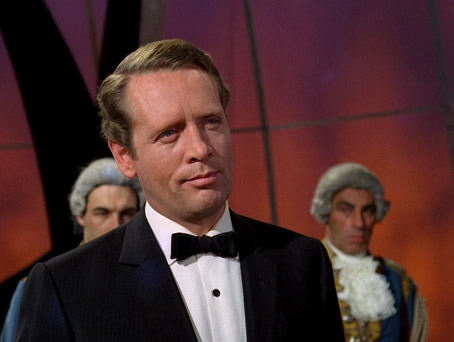
I'll state up front that for me, the thing that made The Prisoner such extraordinary, revolutionary television was less down down to its core themes – bold, crucial and forward thinking though they definitely were – but the mesmerising manner in which they were communicated. The programme was and remains one of television's true originals, a series like no other and that none have even tried to emulate. Nothing on television before or since looked or sounded remotely like it, a testament to its extraordinary location and production design, its vibrant use of colour (and remember, when it was first transmitted most were watching in black and white), its crisp 35mm cinematography, its sometimes astonishing slight-of-hand editing, and it's unique use of nursery rhyme tunes and library music, which created a sinister cheerfulness that is somehow all the more unsettling than any dark and gothic approach could ever have been. It's this unrestrained creativity that has already disinterested me in the upcoming remake, the trailer for which suggests a series that has none of the original's visual uniqueness and which looks – dramatically as well as visually – no different from the plethora of other mystery-driven American genre shows that have fallen from the skies in the wake of the The X-Files. Indeed, it feels almost perverse to take a show that looks and plays like nothing else on TV and remake is one that seems determined to blend in with the crowd. Maybe it will be better than the trailer suggests. Frankly, I couldn't really care. Since it's highly unlikely to come close to the originality of the series it is reworking – seriously, how could it? – then I can't come up with a remotely convincing reason to even watch it. Over to you on that one, Camus.
Countless articles and even a number of books have been written about The Prisoner, and it has already been explored in considerable detail on this very site by Camus in his three-page review here, to which there is little I can add without repeating his words. The purpose of this review is thus to outline what makes this brand new Blu-ray box set so different to previous DVD releases. Oh where do I start? Well how about...
Oh...wow. The two authors of this article are both long-term Prisoner devotees, and the news that the series was to be released on Blu-ray prompted some perhaps unreasonably high expectations. And why not? The series was shot on 35mm, that most wonderful of image recording formats, and we've also had the pleasure of seeing two episodes projected onto a sizeable cinema screen, so are quite aware of how good it can look. But I genuinely wasn't ready for this.
There's only one word for the picture quality of this new, high definition transfer: stunning. Actually, that's not completely true, there are many words I could use, but they're all superlatives and all fully justified. This, my friends, is what you bought that 1080p TV and that Blu-ray player to see. No matter how good your television and how expensive your DVD player, I can guarantee beyond all question you have never seen The Prisoner looking anywhere close to how gorgeous it looks here. The contrast is sublime, the colours burst from the screen, and the picture detail is consistently fabulous. You're first clued in during the title sequence with the clean lines of the speeding Lotus and the precision architecture of the Houses of Parliament, but it's when No. 6 walks in to the Village shop to buy a map that my eyes really popped, as it felt like someone had come in and restocked the shelves with three times as much produce as there was on the DVD version. Other such sharpness barometers in the first episode include being able to see the thread and pattern of the cloth on No.2's chair and the stitching and intricate pattern on the dressing gown on the old woman at the hospital, but the evidence is everywhere, from the detail of the foliage to the richness or the paintwork on the loud speakers. In both The General and A Change of Mind I was amazed that I could see every single pin-sharp hair on a man's beard, sweat is visible on faces in several episodes where I was previously unaware of it, and Dance of the Dead is littered with examples, detailing every crease on Mary Morris' lizard-like face (something I'm sure she'd not have thanked the filmmakers for) and going into overdrive during the climactic costume ball, where I found myself pausing the disc just to gaze in wonder at just how much information had been crammed into the 1.33:1 frame. If there's a down side to this quality leap it's in The Girl Who Was Death, whose back projection work now stands out a mile, and every now and again throughout the series there's a single, noticeably softer shot that suggests an issue with the original footage. The process work on The Schizoid Man is also intermittently detectable, but stands up far better than you might expect. As you would hope, there's not a dust spot to be seen, and the occasional picture flicker is no distraction here. I realise that there is an element of subjectivity to my reaction – after all, it's a series I know well and have watched many times, so am acutely tuned to even the smallest improvement in picture – but The Prisoner now sits alongside Planet Earth as a title I use to show those who have not yet moved up to Blu-ray what they're missing.
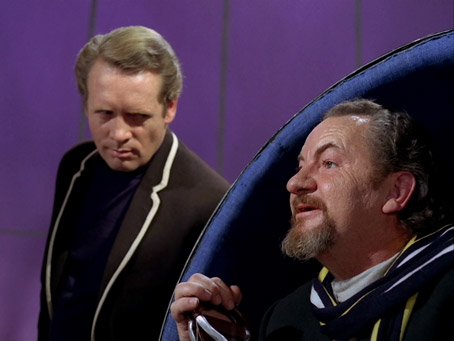
Click on the picture for a full-size screen grab
The original mono 2.0 soundtrack has been included, but has here been joined by a 5.1 remix for each episode. Don't get too excited as there's not a huge difference – certainly sound are not directed around the room in the manner of a modern action movie – but there is some detectable separation at the front and the increased dynamic range gives the music and dialogue a slightly subtler edge and the distinctive groans of the Rover a more threatening bass punch.
This is a six-disc set, the first four of which are Blu-rays containing the episodes and high-definition extras, the last two DVDs with standard definition (though still visually high quality) extras.
Disc 1
Arrival with audio commentary featuring Bernie Williams (production manager) and Tony Sloman (film librarian)
A busy and informative first commentary that kicks off with a tour of the locations used for the opening sequence, then moves on to cover a number of aspects of the episode's and the series' production, including the costumes, the production design, the underlying themes, the difficulties of location filming (the weather, having to work round the tides and the tourists), the use of crew members and locals in bit parts, and the original design and sound for the Rovers. There are a couple of amusing anecdotes about the shoot, particularly one involving a helicopter and chimney soot, and some interesting parallels drawn between the use of numbers in the series to a modern world in which whey have become part of every aspect of our lives, from credit cards to Chinese restaurant menus. Praise aplenty is apportioned to McGoohan, who it is claimed worked seventeen to eighteen hours a day and put his heart and soul into the series, through the first allusions to his staunch Catholicism and discomfort with women are made here. All three contributors seem genuinely excited at the prospect of seeing the series in high definition, as well they might.
Chimes of Big Ben commentary featuring Vincent Tilsley (writer)
With only episode writer Tilsley on board, this is a slightly less lively affair than the Arrival commentary, with some longer dead spots towards the end and small stretches where Tilsley simply passes positive comment on the action on screen, although this is revealed to have purpose when you realise that he is reacting to how his words have been visually interpreted. Nestled in here is some very interesting stuff, however, as Tilsley reveals that he was writing for the original design of the Rover and bemoans the way the redesigned one is defeated with rifle shots ("a couple of shots in the body and it just runs away"), that a key change was made to one sequence because of McGoohan's refusal to do anything even resembling a love scene, and that dialogue that called the church into question was removed because of the actor/producer's staunch Catholicism. It ends on gently delivered but rousing attack on governments, commercialism and the present use of terrorist paranoia as a method of social control.
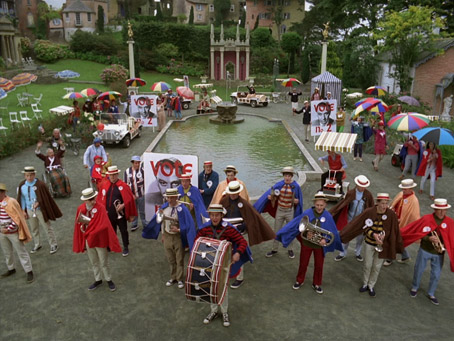
The Schizoid Man with audio commentary featuring Pat Jackson (director)
A more sedate commentary from director Jackson, hardly surprising when you consider he's now a sprightly 93 years old. He outlines how he became involved in the series, how it was first inspired, and talks about the importance of planning and particularly a solid shooting script. He also talks about McGoohan's early career indecision over whether to become a priest or an actor, but the most unexpected diversion sees him recount his first experience with LSD. There's not a lot of screen specific stuff here, but it's definitely of interest.
Episodic Image Gallery with Music Suite (19:24)
A rolling gallery of production and behind-the-scene stills for the episodes on this disc, all gorgeously reproduced at a size that vertically fills the screen (nice to see they've not been cropped to fill it), accompanied by music cues written for the series by Ron Grainer, Wilfred Josephs, Albert Elms and Robert Farnon, all of which have been sourced from archive masters. Quality-wise this knocks the socks off of any such gallery I've yet seen and really is worth watching. It even has chapter stops on the divides between the episodes.
There are also Trailers for Arrival (1:03), The Chimes of Big Ben (1:02), A. B. and C. (1:02), Free for All (1:03) and The Schizoid Man (1:02). They voice-over suggests they were for the original American screening and are in fine shape.
Disc 2
The General with Audio Commentary featuring Peter Graham Scott (director)
Another unhurried commentary in which episode director Scott reveals that he was called in by McGoohan at the last minute to replace the original director, who is tactfully not named. Like the others, he sings the praises of McGoohan's talent and is more episode specific in his anecdotes than Jackson, though there are a lot of dead spots in the second half and a slightly iffy sound mix almost loses his soft voice under the din of the climactic punch-up. A memorable moment sees him refer to the 'disastrous dreariness' of current ITV television.
Dance of the Dead audio commentary featuring Bernie Williams (production manager), Tony Sloman (film librarian) and John S Smith (editor)
A busier commentary that kicks off with the news that Trevor Howard was originally due to play No. 2 in this episode but had to drop out due to ill health, which prompts some comments about how he would look dressed up as Peter Pan in the climactic costume ball. All three speculate on how good McGoohan would have been as Bond, but suggest he would never have taken the role due to the required love scenes, which by this stage of his career he was refusing to do. We are informed that this was the most expensive TV series of its day, but as the filmmakers observe, it's all up on screen, and it's clearly work they're all proud of. At one point the commentary stalls, a gap that is broken by the admission, "We're all spellbound by this, aren't we." The series' themes are once again seen to be pertinent to the modern age, as one of the trio remarks: "Give a man a gun...beware. Give a man a uniform...beware. Give a man authority...beware."
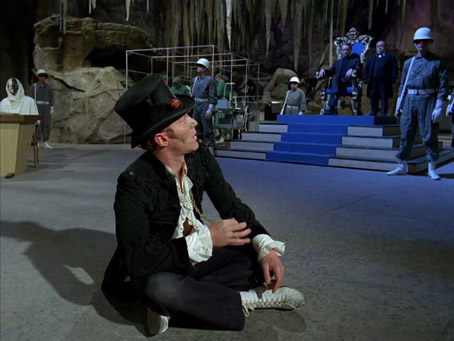
Episodic Image Gallery with Music Suite (12:21)
As on disc 1, but for the episodes on this disc and with the similarly impressive picture and sound quality.
Trailers for The General (1:03), Many Happy Returns (1:04), Dance of the Dead (1:03), Checkmate (1:02) and Hammer Into Anvil (1:03). It's worth catching these for dramatic American voiceover alone.
Disc 3
A Change of Mind with audio commentary featuring Roger Parkes (writer)
One thing I've learned from this set is that writers do good commentary, and Parkes certainly delivers here, providing detailed background on the writing of the episode, his experiences on it and even his career as a TV episode writer and magistrate. He's also the one contributor here who's not a member of the Patrick McGoohan fan club, disgruntled at the prospect of him directing the episode after the original director was fired ("My first born was about to be strangled by this egomaniac actor") and describing him as "a right pain to work with" and having "an exhorted brand impression of himself." He does admit that some of this was down to his own inexperience of the filmmaking process – this was his first credited script, after all – and grudgingly credits McGoohan with making a decent job of it in the end. He remains pleased with the episode as a whole, which he credits in part to his freshness to the scriptwriting process, "presumably before the erosions of hacksville had set in."
Episodic Image Gallery with Music Suite (17:59)
As before, same high quality. Honestly, some of the stills are pin-sharp and crammed with detail.
Trailers for It's Your Funeral (1:02), A Change of Mind (1:04), Do Not Forsake Me Oh My Darling (1:03), Living in Harmony (1:03) and The Girl Who Was Death (1:04).
Disc 4
Fall Out with audio commentary featuring Eric Mival (music editor) and Noreen Ackland (editor)
Any apprehension triggered by the elderly Ackland's slow self-introduction is quickly dispelled as she and Mival engage in a thoroughly engaging discussion on all aspects of the episode, particularly, as you might expect, the editing and the music. Ackland points out the sequence that was edited by Eric Boyd-Perkins and expresses her relief that it fell to him because she couldn't make sense of it. There are some intriguing anecdotes and asides, with Mival revealing that a technique he employed for changing the speed of sound without altering its pitch was borrowed from a certain Stanley Kubrick, who was next door on the MGM lot shooting 2001: A Space Odyssey. Those looking for clarification on what remains one of the most talked about episodes in the history of television will get no help here – asked by Mival if she knew what McGoohan was on about, she replies "No, definitely not." It doesn't matter, this is still one of the best commentaries in the set.
Episodic Image Gallery with Music Suite (12:12)
As before.
Trailers for Once Upon a Time (1:02) and Fall Out (1:03), plus two Generic Trailers (0:54 and 1:30).
Arrival original edit (50:38)
The original edit of the first episode, and there are enough differences just to the opening sequence alone – including the use of different shots and an earlier main theme – to make this of serious interest to series fans. Structurally it's the same episode, but the small changes to shots, edits, music cues and even the sounds made by Rover should make for a nerdy but enjoyable 'spot the difference' game for hardcore devotees. The episode has been restored and given an HD transfer, but the colours are noticeably faded here
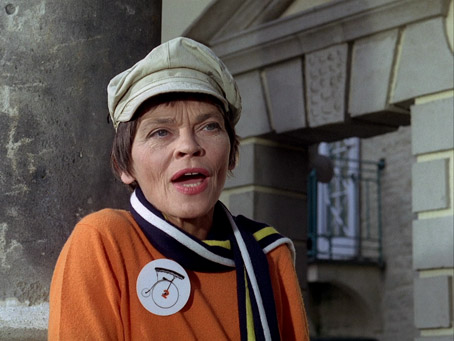
Arrival original edit with music only (50:38)
Exactly what it claims to be, the original edit with no dialogue or sound effects, which does serve to focus your attention on the very considerable contribution of the music editor.
Arrival original edit restoration (3:59)
A side by side comparison between the restored and unrestored first four minutes of the original edit of Arrival. The differences between the two, particularly in contrast and colour, are quite striking.
Textless Material [mute] (10:35)
A compilation of episode and test footage minus the credits. A little more information on this is probably provided in the release version. Some of this also appears on one of the included DVD discs.
Disc 5 (DVD)
Don't Knock Yourself Out (94:55)
If you are new to the series, two things; you lucky sod and don't watch this show until you've enjoyed all 17. The entire dénouement of the last episode is played out and you wouldn't want to see that ahead of time.
This feature length documentary narrated by Neil Pearson is essentially the real behind the scenes from the people who were there and not just the actors. Those who have since died are brought back via what's credited as 'archive' but most are interviews taken from other Prisoner related documentaries. And for once we are spared nothing in terms of emotional recall, which in Anette André's case means revealing how much she hated McGoohan and wanted out as soon as possible. You get a very real sense that McGoohan descended into a very lonely pit, perhaps even had some sort of breakdown. One of the editors recalls playing a 20 foot shot backwards and forwards for McGoohan at her shoulder for about an hour crying with frustration because McGoohan was incapable of knowing what he wanted. As a trainee editor at the BBC, I used to watch the 'star' editor at the time and he'd replay cuts over and over again. I kept on thinking, what is he not seeing? I thought it was how you arrived at a creative decision. It turns out that that was how he arrived at a creative decision.
Co-creator George Markstein quite frankly sums up McGoohan as a ego-maniacal monster whose last roll of the Village dice – the sublime Fall Out – was a pantomime. To be fair, you can sort of see this from his position. Production manager Bernard Williams makes the best contributions (he was at the heart of it all) and it was great to finally see what the man looked like, the man who brought Rover into existence. Like the malfunctioning shark in Jaws, the failure of a prop led to something much more effective. The Prisoner would not be The Prisoner without Rover. Most of the writers of the series have their say and that is terribly refreshing. The only negative aspect of the documentary is that it appears to have been shot very much on the cheap (all participants up against a blue screen where stills of Portmeirion are added in post). It works through. The other footage running underneath commentary is the lava lamp rushes featured on the other DVD Extras. It's pleasant but you wouldn't want a pint of it.
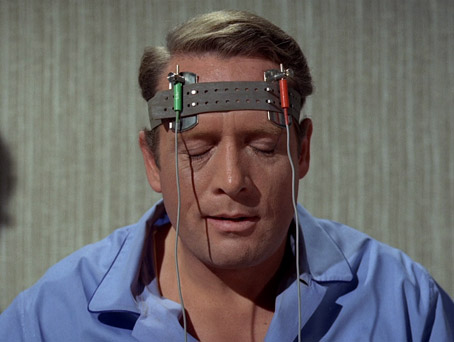
Steven Rick's footage of the original Rover and Bernard Williams' contributions to the fiasco that was Rover Mark One are a highlight. It is very difficult to see how anyone would take a fairy cake with a lamp on it as something scary. It looked like a Horta on its wedding day. That's a nerd reference and if you get it, you're one of us, which is slightly alarming. All told, this documentary is pure gold for Prisoner fans although most obsessives like this writer knew about 90% of the information but was very glad to get an extra, brand spanking new 10. And it was 40 years ago so most participants do indeed look all their advanced years.
You Make Sure It Fits! (9:16)
Eric Mival explains how he got the job as music editor on the series and what the job entails, as well as introducing us to the series' Music Bible.
The Pink Prisoner (9:21)
An interview with actor Peter Wyngarde about his work on the series. Of interest, but the attempt to add a comic element by mumbling the questions incoherently through a sock is distracting and inappropriately silly, and the whole thing feels a little rehearsed.
Exposure Strip Gallery [mute] (10:30)
A rolling gallery of 200 printed colour frames used as a guide to the colour of the shot footage, as each day's rushes were printed in black-and-white as a cost saving. Includes some unused shots and alternative angels.
Ad Bumpers (0:17)
The deconstructing and reconstructing penny-farthing image that led into and out of the ad breaks on the series' TV screening, which have been removed from the versions on the discs. This does add to the sense that we're looking at the definitive release here.
Textless Titles
The front and end title sequences with all three of the scores composed for the purpose – the rejected ones by Wilfred Josephs (3:07) and Robert Farnon (3:05) and the one we all know and love by Ron Grainer (3:07) – all without the sound effects.
Filing Cabinet Footage [mute] (2:29)
The filing cabinet footage from the opening titles with the word 'Resigned' in five different languages, presumably for foreign sales of the series.
Rover Footage [mute] (0:26)
Test footage of the weather balloon Rover, which also appears on the Textless Material extra on disc 4.
McGoohan Montage from Arrival [mute] (0:50)
Rolling gallery of monochrome photos of McGoohan, including baby pics. This also appeared in disc 4's Textless Material.
Behind the Scenes Footage [mute] (45:42)
A compilation of 16mm recce footage shot by Leslie Gilliat during his short time on the show, plus three separate standard 8mm rolls taken by holidaymakers and visitors at the time of filming. Much of Gilliat's footage consists of hand-held wide shots of the location and architecture, but the second half moves in on the filmmakers at work, which although mute is still valuable stuff, and includes the test run of the ludicrous original concept for Rover.
Disc 6 (DVD)
The Chimes Of Big Ben Original Edit (50:47)
Never intended to be broadcast, here's the episode that sports two different edits. Now I am the first to get excited when something different turns up, an aspect of a beloved series or movie that I've never seen before. But let's get real here. Edits go through many versions and this alternate version of The Chimes of Big Ben is nothing of the sort. It's an old cutting copy that got broadcast by mistake in Canada.
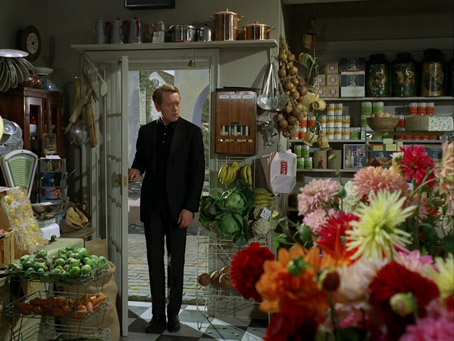
The first striking thing is the absence of the familiar theme and the inclusion of the sound effect of the name of the episode, the literal chimes of Big Ben. Throughout there are some appallingly unmixed sound edits (but the state of the print – terrible – tells you this is a cutting copy with very, very roughly mixed sound). The alternate main theme (by Wilfred Joseph) kicks in halfway through the opening credits. The post title montage is subtly different with two Rover attack shots never seen in the original series.
In the main body of the episode, the scene of No. 6 trying to fix his position from the stars using what's known as a triquetrum was the only significant difference between the cutting copy and the broadcast version. And its inclusion in the edit is clumsy. No. 6's high pitched "Good evening!" as No 8 leaves No. 2's Green Dome is significantly at variance with the rather dry explanation of a device that appears out of the blue and is never seen again. We also have lost a night zoom out from the Green Dome that preceded No. 8's stair climbing.
The end credits play under the same alternate theme from the opening. The difference is in the penny-farthing animation. Once complete, it's smaller wheel dissolves into the world globe and the larger one a circular 'rest of the universe'. This universe then becomes the backdrop to a zoom in to the east African coast and a white lettered red square saying POP. WTF indeed. There are many different stories as to what all this is supposed to mean but the man best placed to answer them died a little while back. But there are a great many 'POP's in the episode Once Upon A Time (aka Degree Absolute) so maybe there is something to be mined. Anything I have to say on the matter is needless noise.
Promotional Image Gallery [Mute] (2:17)
Here are 44 stills (mostly black and white, some colour and some two frame 35mm blow ups) of McGoohan and The Prisoner in production. These could be slides but as there's a clapperboard thrust in frame on some of them, my feeling is that these are 35mm frame blow-ups. Some of these shots will be very recognisable to fans.
1967 Press Conference Gallery [Mute] (2:33)
This features 50 black and white stills of the event. McGoohan, with reasons known only to himself, decided to have a bit of fun with the 1967 official press launch of the series. Using the cage from Once Upon A Time and wearing a Kosho uniform (the Village's violent variation on 'squash'), McGoohan probably succeeded in confusing and alienating those to whom he would have been wise to pander. What am I talking about? It's McGoohan! Of course he'd pull a stunt like this. Angelo Muscat is on hand and there's a fun series of stills charting Alexis Kanner's falling off a penny-farthing.
Production Designs Gallery [Mute] (0:51)
16 colour charcoal drawings which depict many moments from the series and a few that didn't make it.
Lava Lamp Footage [Mute] (7:43)
How to grow a Rover. Now this is more like it… Almost 8 minutes of staring at a lava lamp! This is what they want. Perhaps a little bit, perhaps 30" but almost eight minutes? I admit, I zoomed through it. I wonder what prompted this inclusion? How about "We've got it, let's stick it in!" which is as good a reason as any.
Televisions Greatest Hits Interview (2:47)
This made me cringe when I saw it first and now, pristine in standard definition, it makes me cringe even more. What is it about the series that reduces interviewers (in this case, Mike Smith) to asking the same boring questions and embarrassingly recoiling from a mini Rover…. McGoohan acquits himself well and I see some familiar faces all dressed up behind him but it is a slightly embarrassing affair, all told. And it's all way too short having McGoohan there in the studio and using just under three minutes of interview. It's an example of that old Woody Allen joke about a chicken dish in Treskeys Restaurant – "The food in here is terrible," "Yes, and such small portions."
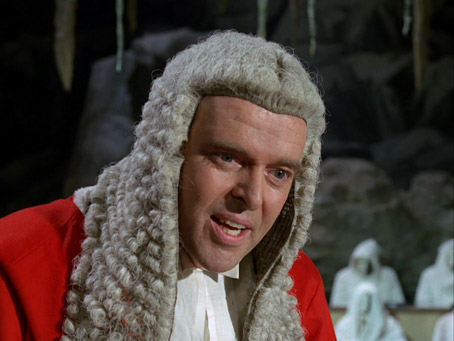
Audio Interview with Patrick McGoohan (47:47)
This is fascinating despite the variable sound quality. McGoohan admits to being very nervous on radio and puts the record straight on being misquoted and he comes across as having a very strict moral centre. He talks about his surprise at some countries having compulsory seat belt regulations. The interview was recorded in 1980 (if the 13 years mentioned in the interview is taken from 1967) so seat belt legislation wasn't enforced in the UK at that time. McGoohan is talking about risk being part of life and that the more the state molly-coddles us, the fewer freedoms we enjoy. Yeah, well, to me, not having to wear a seat belt is not a freedom I gave up unhappily. McGoohan seemed to infer that people who really knew how to drive never wore one. I just don't have a great yen to fly out of the car at 70 mph if I hit something. But then I guess hitting something at 70mph makes me a bad driver. I'll clunk-click if it's all the same to him.
He tells the story of a CBS executive coming over to talk business with mogul and Prisoner financier Lew Grade and the post production team having to pull all-nighters to get a cut of Arrival out to screen to this guy. After the screening, the executive was so thrilled he bought the rights to broadcast a whole slew of Lew's shows - sight unseen. McGoohan calls the shows 'junk' and they include more than one Gerry Anderson production. No love lost there then. It seems that McGoohan was never happy with the main theme of The Prisoner. There was a report (who knows if it was apocryphal or not?) that McGoohan hummed the theme he wanted to Ron Grainer who then went and dutifully orchestrated it. In hindsight, McGoohan felt it was too heavy but in the limited time they had to record it, it stands as it is. Odd thing. I offered the words "too strident" as McGoohan was looking for the adjective to describe his dissatisfaction with the main theme. I think if I'd offered that word during the interview, he would have taken it with thanks. This feature is well worth a listen.
DVD-ROM Features
Any Prisoner fan would be in seventh heaven with what's available on the DVD-ROMs. I mean we are talking 'complete' coverage here in the sense of overkill. These are historical PDFs that place The Prisoner fully in context and I'm waiting for a youngster to complain that no one used any other font except Courier in those days. That film and TV production was still possible without computers should not surprise these youngsters. And The Prisoner was made as a TV series without the word 'television' allowed on set. It was 35mm film-making that happened to go out on TV.
Simon Coward, Tony Sloman, Eric Mival and Steven Ricks are all to be thanked for their perseverance and generosity (that is unless Network paid them well for the results of years of collecting and storing). The massive amount of PDF files available with this box set is staggering. The four individuals (each having a significant role in Prisoner fandom and two in production) are to be thanked for making these documents electronically available. We have a lot of different versions of each script for each of the 17 episodes. They all have handwritten amendments and have a sense of authenticity that money can't buy. There are even original scripts that were not produced but were written at the time – one in particular is a good read. It's about a parachuted meteorological agent who tries to gain No. 6's trust in forming an escape plan. It turns out (surprise!) that he's working for the Village authorities. The title of this un-produced teleplay? The Outsider by Moris Farhi.
There are high resolution Village newspaper 'Tally Ho' scans which reveal some surrealistic 'junk text' to fill up what appears to be a valid newspaper, words and sentences that pre-date those same email random word sentences that try to get past junk filters today. They are entertaining reading in and of themselves. How about this as a sentence?
"The porcupine directly he is and snarled. But the squirrel was really good at their duty and worthy or promotion just like (sic) Well so they do exist to-day in return to his village and then he of his religious beliefs."
Glorious stuff.
There are numerous press releases, production information, TV Times Cover art, comic covers and toy advertisements and also documents directly used in production like call sheets, movement orders and progress reports – absolutely fascinating stuff for any Prisoner fan. Great stuff.
Absolutely bloody marvellous. Never did I in my wildest dreams did I ever think I'd see what two of us here still regard as the greatest TV series ever made presented so beautifully and with such a fabulously comprehensive set of extras. For Prisoner fans this is the home video equivalent of the Holy Grail – if you have a Blu-ray player then it's an essential purchase, if you don't then it's time to buy one. This is a brilliant box set and without question my favourite UK Blu-ray release to date. Seriously, I cannot recommend this highly enough. Wonderful.
|